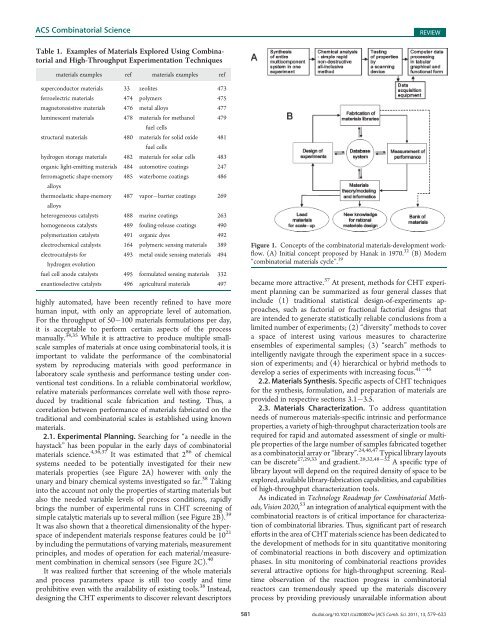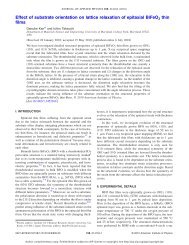Combinatorial and High-Throughput Screening of Materials ...
Combinatorial and High-Throughput Screening of Materials ...
Combinatorial and High-Throughput Screening of Materials ...
Create successful ePaper yourself
Turn your PDF publications into a flip-book with our unique Google optimized e-Paper software.
ACS <strong>Combinatorial</strong> Science<br />
REVIEW<br />
Table 1. Examples <strong>of</strong> <strong>Materials</strong> Explored Using <strong>Combinatorial</strong><br />
<strong>and</strong> <strong>High</strong>-<strong>Throughput</strong> Experimentation Techniques<br />
materials examples ref materials examples ref<br />
superconductor materials 33 zeolites 473<br />
ferroelectric materials 474 polymers 475<br />
magnetoresistive materials 476 metal alloys 477<br />
luminescent materials 478 materials for methanol<br />
fuel cells<br />
479<br />
structural materials 480 materials for solid oxide<br />
fuel cells<br />
hydrogen storage materials 482 materials for solar cells 483<br />
organic light-emitting materials 484 automotive coatings 247<br />
ferromagnetic shape-memory 485 waterborne coatings 486<br />
alloys<br />
thermoelastic shape-memory<br />
alloys<br />
487 vapor barrier coatings 269<br />
heterogeneous catalysts 488 marine coatings 263<br />
homogeneous catalysts 489 fouling-release coatings 490<br />
polymerization catalysts 491 organic dyes 492<br />
electrochemical catalysts 164 polymeric sensing materials 389<br />
electrocatalysts for<br />
493 metal oxide sensing materials 494<br />
hydrogen evolution<br />
fuel cell anode catalysts 495 formulated sensing materials 332<br />
enantioselective catalysts 496 agricultural materials 497<br />
highly automated, have been recently refined to have more<br />
human input, with only an appropriate level <strong>of</strong> automation.<br />
For the throughput <strong>of</strong> 50 100 materials formulations per day,<br />
it is acceptable to perform certain aspects <strong>of</strong> the process<br />
manually. 34,35 While it is attractive to produce multiple smallscale<br />
samples <strong>of</strong> materials at once using combinatorial tools, it is<br />
important to validate the performance <strong>of</strong> the combinatorial<br />
system by reproducing materials with good performance in<br />
laboratory scale synthesis <strong>and</strong> performance testing under conventional<br />
test conditions. In a reliable combinatorial workflow,<br />
relative materials performances correlate well with those reproduced<br />
by traditional scale fabrication <strong>and</strong> testing. Thus, a<br />
correlation between performance <strong>of</strong> materials fabricated on the<br />
traditional <strong>and</strong> combinatorial scales is established using known<br />
materials.<br />
2.1. Experimental Planning. Searching for “a needle in the<br />
haystack” has been popular in the early days <strong>of</strong> combinatorial<br />
materials science. 4,36,37 It was estimated that 2 86 <strong>of</strong> chemical<br />
systems needed to be potentially investigated for their new<br />
materials properties (see Figure 2A) however with only the<br />
unary <strong>and</strong> binary chemical systems investigated so far. 38 Taking<br />
into the account not only the properties <strong>of</strong> starting materials but<br />
also the needed variable levels <strong>of</strong> process conditions, rapidly<br />
brings the number <strong>of</strong> experimental runs in CHT screening <strong>of</strong><br />
simple catalytic materials up to several million (see Figure 2B). 39<br />
It was also shown that a theoretical dimensionality <strong>of</strong> the hyperspace<br />
<strong>of</strong> independent materials response features could be 10 21<br />
by including the permutations <strong>of</strong> varying materials, measurement<br />
principles, <strong>and</strong> modes <strong>of</strong> operation for each material/measurement<br />
combination in chemical sensors (see Figure 2C). 40<br />
It was realized further that screening <strong>of</strong> the whole materials<br />
<strong>and</strong> process parameters space is still too costly <strong>and</strong> time<br />
prohibitive even with the availability <strong>of</strong> existing tools. 38 Instead,<br />
designing the CHT experiments to discover relevant descriptors<br />
481<br />
Figure 1. Concepts <strong>of</strong> the combinatorial materials-development workflow.<br />
(A) Initial concept proposed by Hanak in 1970. 32 (B) Modern<br />
“combinatorial materials cycle”. 19<br />
became more attractive. 37 At present, methods for CHT experiment<br />
planning can be summarized as four general classes that<br />
include (1) traditional statistical design-<strong>of</strong>-experiments approaches,<br />
such as factorial or fractional factorial designs that<br />
are intended to generate statistically reliable conclusions from a<br />
limited number <strong>of</strong> experiments; (2) “diversity” methods to cover<br />
a space <strong>of</strong> interest using various measures to characterize<br />
ensembles <strong>of</strong> experimental samples; (3) “search” methods to<br />
intelligently navigate through the experiment space in a succession<br />
<strong>of</strong> experiments; <strong>and</strong> (4) hierarchical or hybrid methods to<br />
41 45<br />
develop a series <strong>of</strong> experiments with increasing focus.<br />
2.2. <strong>Materials</strong> Synthesis. Specific aspects <strong>of</strong> CHT techniques<br />
for the synthesis, formulation, <strong>and</strong> preparation <strong>of</strong> materials are<br />
provided in respective sections 3.1 3.5.<br />
2.3. <strong>Materials</strong> Characterization. To address quantitation<br />
needs <strong>of</strong> numerous materials-specific intrinsic <strong>and</strong> performance<br />
properties, a variety <strong>of</strong> high-throughput characterization tools are<br />
required for rapid <strong>and</strong> automated assessment <strong>of</strong> single or multiple<br />
properties <strong>of</strong> the large number <strong>of</strong> samples fabricated together<br />
as a combinatorial array or “library”. 24,46,47 Typical library layouts<br />
can be discrete 27,29,33 <strong>and</strong> gradient. 28,32,48 52 A specific type <strong>of</strong><br />
library layout will depend on the required density <strong>of</strong> space to be<br />
explored, available library-fabrication capabilities, <strong>and</strong> capabilities<br />
<strong>of</strong> high-throughput characterization tools.<br />
As indicated in Technology Roadmap for <strong>Combinatorial</strong> Methods,<br />
Vision 2020, 53 an integration <strong>of</strong> analytical equipment with the<br />
combinatorial reactors is <strong>of</strong> critical importance for characterization<br />
<strong>of</strong> combinatorial libraries. Thus, significant part <strong>of</strong> research<br />
efforts in the area <strong>of</strong> CHT materials science has been dedicated to<br />
the development <strong>of</strong> methods for in situ quantitative monitoring<br />
<strong>of</strong> combinatorial reactions in both discovery <strong>and</strong> optimization<br />
phases. In situ monitoring <strong>of</strong> combinatorial reactions provides<br />
several attractive options for high-throughput screening. Realtime<br />
observation <strong>of</strong> the reaction progress in combinatorial<br />
reactors can tremendously speed up the materials discovery<br />
process by providing previously unavailable information about<br />
581 dx.doi.org/10.1021/co200007w |ACS Comb. Sci. 2011, 13, 579–633












